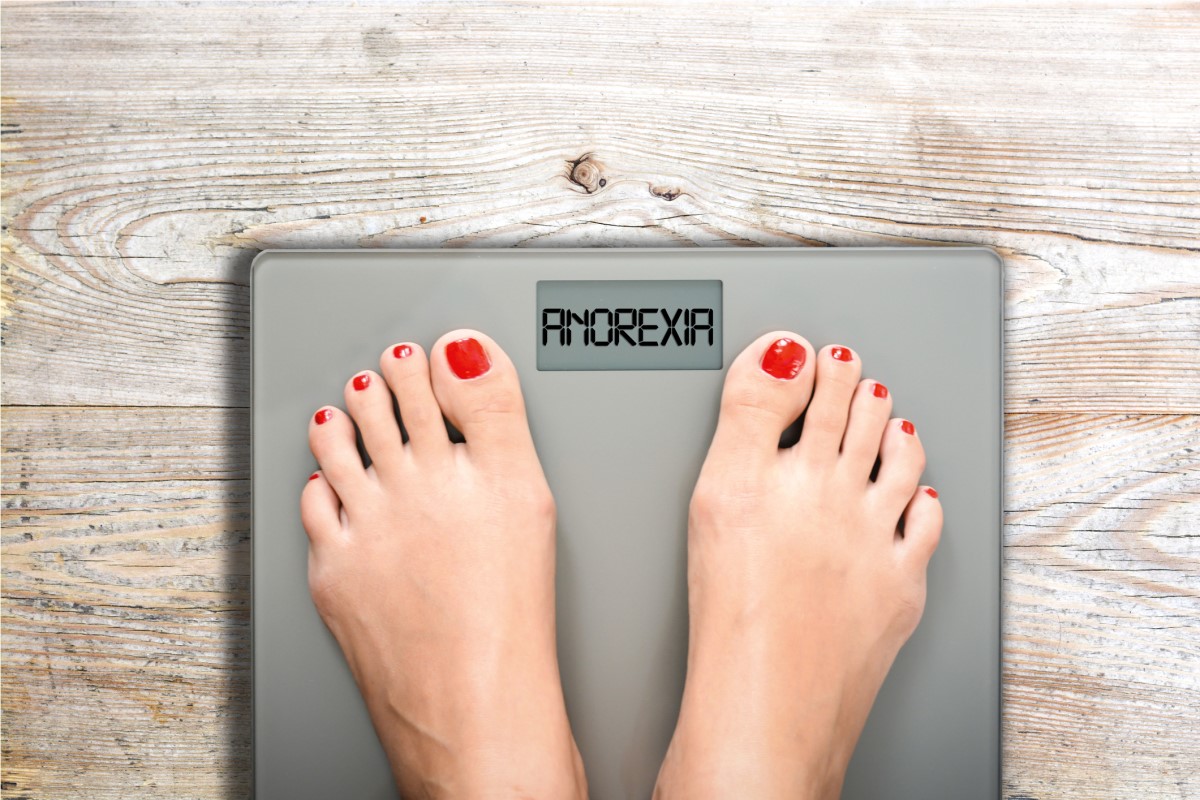- solen.sk - Eating disorders, diagnostic and therapeutic pitfalls
- prolekare.cz - Effect of anorexia nervosa on bone metabolism
- prolekare.cz - Prevention of eating disorders
- prolekare.cz - Mental anorexia with early onset, diagnosis and therapy
- mzsr.sk - Comprehensive treatment of eating disorders
- prolekare.cz - Eating disorders from the perspective of a paedopsychiatrist
- prolekare.cz - Eating disorders - mental anorexia and mental bulimia, the most serious somatic and metabolic complications. Methods of realimentation Summary of 30 years of practice from the metabolic perspective of an internist
- webmd.com - ANOREXIA NERVOSA
- nhs.uk - Overview - Anorexia
- schoen-clinic.co.uk - Anorexia nervosa
Girls are the main sufferers of anorexia nervosa: What are its symptoms? Boys are no exception

People often associate anorexia with modelling, but the disorder affects many teenage girls, not just models.
Most common symptoms
- Malaise
- Tremors
- Apathy
- Abdominal Pain
- Spirituality
- Cramps in the abdomen
- Nausea
- Head spinning
- Constipation
- Depression - depressed mood
- Diarrhoea
- Brittle nails - onychoschizia
- Brittle hair
- Excessive Hair Loss: Causes, Treatment
- Indigestion
- Low blood pressure
- Malnutrition
- Erectile dysfunction
- Concentration disorders
- Menstrual cycle disorders
- Memory disorders
- Disorders of consciousness
- Mood disorders
- Dry mouth
- Tremor
- Bone thinning
- Cramping in the abdomen
- Slowed heartbeat
- Cold extremities
- Dry skin
- Muscle weakness
- Muscle cramps
- Fatigue
- Anxiety
- Vomiting
- Confusion
- Decrease in libido
Characteristics
Mental anorexia is an eating disorder. Eating disorders are more common in girls. The development of eating disorder symptoms occurs during childhood and adolescence.
After asthma and obesity, eating disorders are the most common health problem in adolescent girls and young women.
Mental anorexia is a disorder characterised by deliberate weight loss. It is considered a serious psychosomatic illness. In Western European countries, the prevalence of this disorder is between 0.3 and 0.5 %.
Currently, the number of patients is increasing.
Currently, anorexia occurs in 8 out of 100 000 people.
The disease is most common in adolescent girls.
Boys, young men, pre-pubertal children and older women are rarely affected. It most often starts around the age of 13. The highest incidence of anorexia nervosa is between the ages of 15 and 19.
There is no difference in the prevalence of anorexia nervosa between urban and rural populations. It is approximately equally prevalent in both. Girls from middle and upper socioeconomic classes are most often affected. Professional dancers and ballerinas are the most vulnerable group.
Anorexia = mental anorexia = anorexia nervosa - from Greek "an" (lack, deprivation) + "orexis" (craving)
History
Many of us consider mental anorexia to be a modern problem. However, the eating disorder was first mentioned by Galen. Hippocrates first named the disorder anorexia nervosa. In 1689, R. Morton was the first to describe the course of mental anorexia.
Did you know that...
In the late Middle Ages, the Church declared many women saints because of their strange behavior that resembled that of anorexics. During the Reformation, such women were considered to be possessed by the devil.
Causes
Mental anorexia is a multifactorial disorder. The development of anorexia nervosa is the result of developmental, biological, psychological and social factors.
The emergence of anorexia nervosa is most commonly explained using the neurodevelopmental multifactorial threshold model.
According to this model, the onset of anorexia nervosa results from the interaction of brain developmental factors, early relationships and stress.
Mental anorexia is the body's lack of adaptability to stress during adolescence in genetically predisposed individuals.
Physical changes during puberty, estrogen levels, and adrenal gland activity are also involved in the development of the disease.

1. Genetic causes
Women are most at risk of anorexia nervosa. According to scientific studies, genetic influences are involved in about 50-83% of cases.
According to the results of twin studies, the incidence of anorexia nervosa is higher in first-degree relatives.
The prevalence of eating disorders is higher in identical twins than in twins.
2. Psychological causes
According to scientific studies, patients with anorexia nervosa often also suffer from depression, anxiety disorders, obsessive-compulsive disorder and social phobia.
Low self-esteem, negative self-image and feelings of inadequacy are common risk factors.
The mother-daughter relationship is a major factor in the development of the illness. According to observations, many anorexics had a problematic relationship with their mothers. Their mothers were overly controlling and prevented them from being independent as children.
As a result of this relationship, the children were not able to recognise their own needs and wishes in adolescence. The patients lacked childhood experiences and experiences that would have strengthened their independence.
3. Social causes
Anorexia is more common in girls than in boys. Girls in adolescence try to approach the ideal of beauty. Compared to boys, girls in this period are less confident, want to be liked and have lower self-esteem.
Did you know that...
Up to 35% of girls aged 13 are not satisfied with their bodies. And up to 50% of girls at this age want to lose weight.
Today, the Western European ideal of thinness prevails.
The ideal body weight is less than a woman's normal weight. The ideal of thinness is promoted by the media, fashion and celebrities.
This influence has a negative impact on adolescents who are very sensitive about their appearance.

Symptoms
The symptoms of anorexia nervosa are manifold. The changes manifest themselves mentally and physically.
How does a woman who suffers from anorexia nervosa behave?
One of the characteristic features is the desire to lose weight or to keep the weight as low as possible. The patient often looks in the mirror and checks her appearance. She perceives her image in the mirror very critically.
Some patients are aware that they are slim. Yet they are not satisfied with the problem areas (buttocks, thighs, abdomen). Some may show an increased interest in sports.
Avoidance of food is typical.
After eating, the woman deliberately vomits or takes diuretics and laxatives. Some patients may experience episodes of overeating followed by provoked vomiting.
On the other hand, she collects recipes, enjoys grocery shopping and checking the caloric values of foods. She likes to cook for her family and friends.
The disease also affects the woman's psyche. Emotional instability may be a symptom of the disease. The patient may be anxious, sensitive and depressed. Attention deficit disorder may be present. Anorexics often have a fear of physical touch.

what does a woman with anorexia look like?
You should be alert if you notice a woman in your neighborhood with loss of subcutaneous fat, deepening of nasolabial folds, and a generally aged facial expression. A woman with anorexia has dry, peeling skin.
Other symptoms include sensitivity to cold. A woman may have symptoms of frostbite even in plus temperatures.
Another symptom of the disease is so-called limb enlargement. It is caused by a lack of protein, which manifests itself in swelling. A person suffering from anorexia may develop anaemia and a low level of white blood cells (leukopenia).
the following table lists the symptoms of anorexia nervosa
| PSYCHIC | SOMATIC (physical) |
| Fear of fatness | Diarrhoea |
| Food aversion | Weight loss |
| Secretiveness | Constipation |
| Feeling sad | Pancreatitis |
| Depression | Hypotension |
| Feelings of loneliness, helplessness and despair | Bradycardia |
| Suicidal tendencies | Pneumonia |
| Cramps | |
| Memory disorders | |
| Dry skin | |
| Change in hair quality (thinning) | |
| Muscle weakness | |
| Amenorrhoea in women | |
| Loss of potency and libido in men |
What complications can occur with eating disorders?
- Heart problems - heart rhythm disturbances, ECG changes
- Internal disorders - hypokalemia (decreased potassium), hyponatremia (decreased sodium), decreased phosphorus, magnesium, hypocalcemia, loss of stomach acid
- Changes in endocrine function - decreased estrogen levels
Diagnostics
Diagnosis of eating disorders consists of assessing the symptoms of the disease. Diagnostic criteria for anorexia nervosa in adults include:
- Patients struggle to maintain a body weight below 85% of normal weight for their age and height. A BMI of 17.5 or less.
- The patient's weight loss is self-inflicted (use of laxatives, diuretics, provoked vomiting, excessive exercise).
- The patient is underweight but has a constant fear of being overweight.
- Extensive endocrine disorder - amenorrhea in women, loss of sexual interest and potency in men.
Read also: BMI: How to calculate body mass index? Calculator + formula
Diagnosis of the disease in children is different in some points than in adults. According to the body mass index, the condition is evaluated only in adults.
Also, amenorrhea (absence of bleeding) before the onset of puberty is not considered a sufficient criterion for diagnosis.
If anorexia nervosa occurs before puberty, growth may stop. Girls may not develop breasts and boys may not develop genitals.
Diagnostic criteria for eating disorders in children include:
- Deliberate weight loss - avoidance of food, excessive exercise, provoked vomiting
- Morbid preoccupation with weight
- Disproportionate perceptions and beliefs about weight or body shape
Other characteristics of anorexia nervosa in childhood include:
- A personality with features of emotional distress
- Denial of deliberate starvation
- Complaining of abdominal pain and lack of appetite
- Concurrent depressive and obsessive-compulsive syndrome
Read also: What is Obsessive Compulsive Disorder + Symptoms and Treatment
Diagnosis of eating disorders consists of the following steps:
- psychiatric examination (history, clinical picture, psychopathological analysis)
- psychodiagnostic examination
the following table summarises the main topics of conversation during the first interview
| 1. Specific psychopathology: |
|
| 2. Eating habits: |
|
| 3. Weight control methods: |
|
| 4. General psychopathology: |
|
Before starting treatment, patients are examined according to their condition:
- Basic examinations of all patients: blood count, biochemical tests, thyroid function tests, urinalysis, liver tests, ECG
- Examinations in case of disease lasting more than 6 months: osteopenia and osteoporosis examination, densitometry, examination of estradiol and testosterone concentrations
- Other investigations: amylase and lipase concentrations, MRI and CT brain, stool examination
Course
How does anorexia begin???
The course of anorexia varies.
In some cases, there may be a single episode with complete cure. Sometimes there is partial cure with relapses. In the worst cases, patients have a chronic course that ends in death.
In one study, a cohort of 100 patients suffering from anorexia nervosa was followed. Complete cure occurred within 6 years in 50% of cases.
Mental anorexia is most common in girls. It occurs between the ages of 13 and 19. At this age, adolescent girls are very sensitive about their appearance.
Triggers of anorexia nervosa include:
- Physical changes at puberty
- Environmental influences - inappropriate comments about appearance by others
- Stress caused by an unexpected event - death in the family, parental divorce, change of school, bullying
- Somatic illnesses - infections, digestive tract diseases, musculoskeletal injuries
Weight loss increases patients' self-esteem, relieves them of fear and anxiety. For this reason, patients do not admit to health problems and do not perceive them as a serious problem.
Patients suffering from eating disorders live to an average age of 33 years. The mortality rate is approximately 0.7-17.8%. The most dangerous period is between 10 and 19 years of age.

How it is treated: Anorexia - Mental anorexia
Treatment of anorexia: complex, outpatient, inpatient + medication
Show moreAnorexia is treated by
Anorexia is examined by
Other names
Interesting resources










